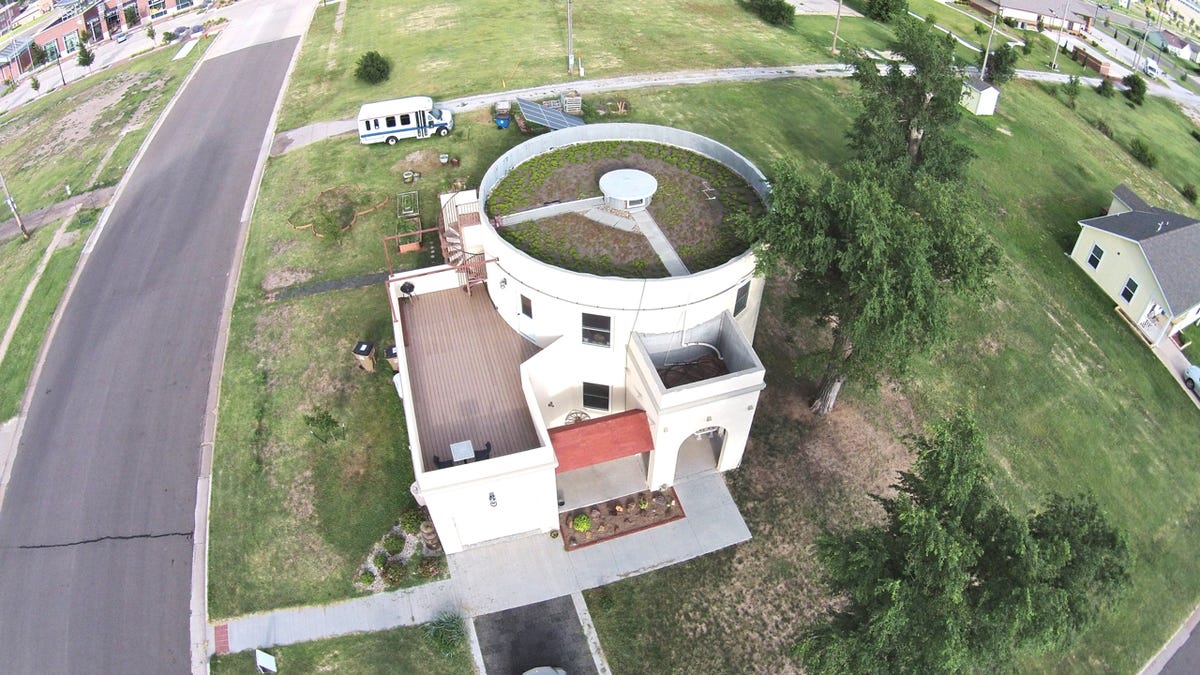Town goes all green after devastating tornado (pictures)
Greensburg, Kan., was leveled by a 2007 twister, then committed to a green rebuilding approach that can be a model for communities everywhere. CNET Road Trip 2014 checked out 'Green Town U.S.A.'

Green model house
GREENSBURG, Kan. -- On May 4, 2007, an EF-5 tornado -- the largest measured in the US in years -- flattened this small town, destroying 95 percent of its buildings.
In the aftermath, the people of Greensburg decided to rebuild with an emphasis on green building principles, and in the years since has become a model for how to develop a sustainable community. It now boasts the highest per-capita percentage of LEED-certified buildings in the United States.
As part of CNET Road Trip 2014, I visited Greensburg to see what "Green Town U.S.A." looked like. This is an aerial view, taken using a DJI Phantom 2 Vision-plus, of Greensburg's Silo Eco-Home, a bed and breakfast and live-in sustainable model home.
Please click here for my full story on Greensburg's rebuilding efforts.
Flattened
An aerial look at Greensburg in the wake of the May 4, 2007, tornado that destroyed 95 percent of the small Kansas town's buildings and killed 12 people.
House outline
In this photo, taken using a DJI Phantom 2 Vision-plus, it's possible to see the Silo Eco-Home (left) as well as a former home site (lower right) that has yet to be rebuilt on. It's possible to see the outline of the original house located on the property, still visible in the overgrown grass.
City Hall and County Commons
In this aerial photo, shot using a DJI Phantom 2 Vision-plus, the roofs of Greensburg's City Hall (left) and County Commons are visible. Both buildings were build using green principles, and are LEED-certified.
5.4.7 Arts Center
The 5.4.7 Arts Center -- named for the date of the tornado -- is a LEED-certified building in Greensburg built with reclaimed wood, and featuring many other green elements. Greensburg has 11 LEED-certified buildings.
Kiowa County Schools
The all-new Kiowa County Schools, in Greensburg, is a sustainable building complex housing the county's entire school system. It features a wide variety of sustainable elements, such as large windows that let in lots of natural light, bleachers made from recycled milk and water jugs, rainwater catchment systems, and much more.
Wind speeds map
A map showing the tornado's wind speeds as it rolled through Greensburg. The strongest winds -- more than 200 miles an hour -- hit the center of town. All told, the tornado was measured at 1.7 miles wide.
City Hall
A look at Greensburg's all-new City Hall.
Remnants
The remnants of a pre-tornado building, still visible in the center of Greensburg.
Grain silo
Although nearly all of Greensburg's buildings were destroyed by the tornado, the town's grain silo was still standing when the storm passed. It became a model for the type of structure that could survive an EF-5 tornado.
Living roof
A living roof on top of the County Commons building provides a number of green benefits, including rainwater absorption and natural cooling.
Water catchment
A water catchment system at the County Schools complex in Greensburg, Kan.
Locker room
The locker room inside the County Schools complex was partially funded with federal money intended for building storm shelters. By placing the locker room inside the shelter, the school board was able to take advantage of "creative financing."
The Big Well
One of Greensburg's main attractions, the so-called "Big Well," as seen from a DJI Phantom 2 Vision-plus.

